The All-in-One Battle: Dell's XPS One 24 vs. Apple's iMac
by Anand Lal Shimpi on October 30, 2008 3:00 PM EST- Posted in
- Systems
The New Apple iMac
It would be impossible, unjust and a disservice to avoid the inevitable: the iMac comparison. I hadn't owned an iMac since the last iMac G5 and the very first Intel based iMac so it was about time that I got a look at one of the updated glass/aluminum models.

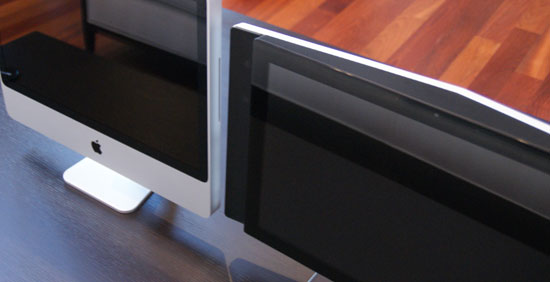
iMac on the left, XPS One 24 on the right
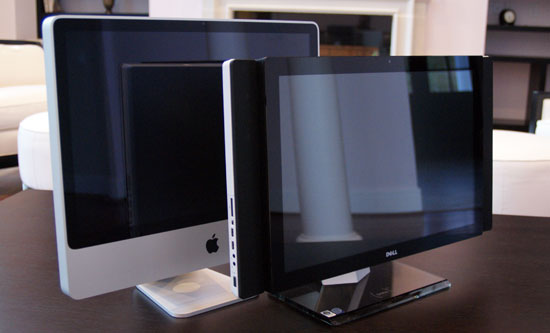
Oh so glossy
If this were an episode of Top Gear you'd see the XPS One and the cameraman would quickly pan to Apple's 24" iMac flying down the runway, and Clarkson would make some snide remark about how Dell had gotten it perfect, but almost.
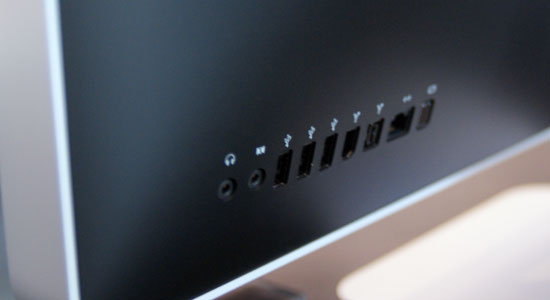
The iMac ports
Enter Apple's iMac, the king of the all-in-one market, not because it's perfect, but because it is the target everyone else seems to aim at. The resurgence in all-in-one PCs is due largely to the success of Apple's iMac, but many seem to forget that the iMac is so successful because there is no other way to get a decent Mac desktop without spending a lot more money on the Mac Pro.
While the XPS One is very wide, the iMac is very tall, despite both using a 16:10 24" panel. The difference is that Apple sticks much of the hardware in the bottom part of the machine, while Dell opted for cooler running mobile hardware to keep its platform both thin and narrow.
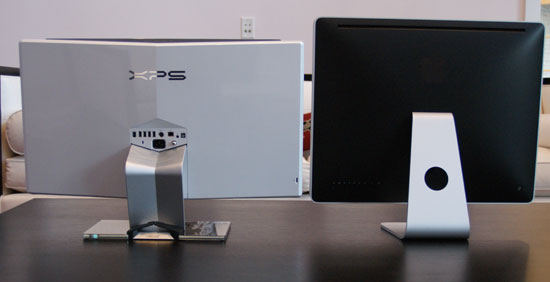
Apple does a better job of hiding its speakers, but the end result is a better sound out of the XPS One. The iMac sounds more muffled while the XPS One comes in a lot clearer, although the highs are overly harsh and you lose a lot of the clarity in the midrange - in both cases you make sacrifices for the form factor, something you should know by now when considering an all-in-one regardless of what logo is on the box.
Like the Dell, Apple's display is glossy and will show reflections but unlike a notebook, presumably you'll be in a more controlled lighting situation with either of these machines so the glare on the screen should be manageable. My kitchen has no curtains or blinds so I put both systems in there naturally and despite the glossy screens being distracting, they were both usable.
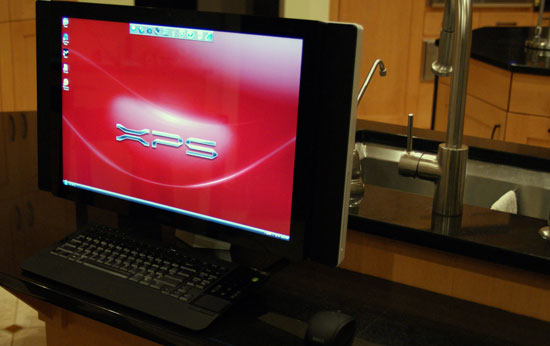
The iMac is pretty decent, the top of the line $2199 configuration gives you a very fast 3.06GHz Core 2 Duo CPU, only 2GB of RAM but a GeForce 8800 GS GPU:
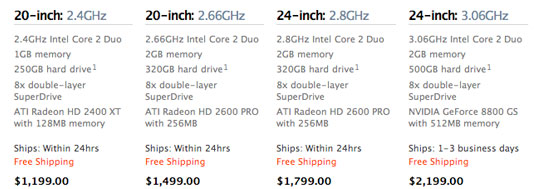
The $1799 configuration skimps on the video, but it's still better than the G45 graphics that are in the $1699 XPS One, but not better than the 9600M that's in the $1999 model. It seems as if Apple and Dell almost worked together to ensure that their pricepoints didn't overlap but rather complemented one another.
Apple continues to skimp on memory and drive size, although admittedly 2GB is enough for most that you'd want to do under OS X. The 500GB drive is acceptable but I'd say that the 320GB version in the $1799 model is a bit too small, especially if you're going to be running Boot Camp.
Apple's Boot Camp works incredibly well, simply tell Boot Camp how much of your hard drive you'd like to use for your Windows partition, stick in your Vista DVD and OS X will reboot into the Vista Installer. Once you're actually in Windows, pop in your Mac OS Disc 1 and Apple will install of the drivers for your iMac.
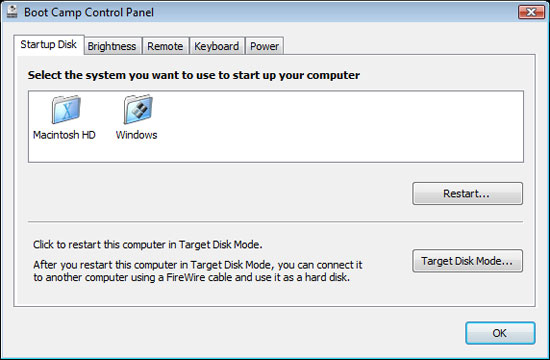
The unfortunate part of this approach is that Apple opts for stability rather than performance with its driver image, and thus the NVIDIA drivers Boot Camp installed were 167.63 compared to 175.29 on the Dell and 178.24 which are the latest publicly available from NVIDIA. Apple's Software Update also fails to update the Boot Camp drivers, unlike how it works under OS X, so you'll have to either rely on Windows Update for driver updates or go off to NVIDIA and grab your own.

Overall Apple's iMac is actually pretty solid; it's got a good enough display (24" 1920 x 1200 H-IPS panel) that you won't feel bad about being stuck with it, it's actually got impressively fast hardware if you opt for either of the 24" models, and with the top of the line system you can actually play most modern games on it with a Vista install. The design is quite stylish and if you're an OS X fan then there's little to complain about, it feels fast and looks great.










60 Comments
View All Comments
nitrous9200 - Friday, October 31, 2008 - link
There will be an option to show the text next to the program icons in 7, but obviously it will be turned off by default. Of course it's really quite easy to differentiate between programs by the icon since they're usually so different.strikeback03 - Monday, November 3, 2008 - link
Yeah, but if you have several instances of the same program open (for example, I have 2 firefox right now, and multiple Explorer windows is common) then icons won't cut it. I couldn't care less how pretty the interface looks, so long as it is effective at conveying what is going on and allowing me to interact with it.sxr7171 - Tuesday, November 4, 2008 - link
No big deal. You will get a choice which is the downside of Macs. It's either "our way" or the "highway" in the Mac universe which is my big issue with Mac.Wolfpup - Friday, October 31, 2008 - link
I've long felt Windows' interface is considerably superior to OS X. Honestly I'd take 98's interface over 10.5, let alone XP or Vistas. It's really customizable, and...well I could go on and on about the things I prefer.(Two huge ones off the top of my head, you can edit files and folders from a save dialog box, and create new documents where you want them in the file system rather than having to open a program and navigate that way.)
Certainly I vastly prefer the quick launch bar and start menu to the dock.
Expose is the only interface element I wouldn't mind ripped off and put in Windows (though even there there's sort of a version of it in Vista).
slashbinslashbash - Friday, October 31, 2008 - link
Hmmm... how long have you been reading AnandTech? I've been here a good 7-8 years now, and I have grown to have an almost personal relationship with Anand's reviews. I know his thought processes, and he has kept a consistent POV over the years. Look back to 2004-2005 when he got his first Macs and somewhat reluctantly concluded (after all, he had built his site's reputation as a PC hardware review site) that he liked OS X better than Windows. Ever since then, the push has been on. Anand has grown to be more and more of a "Mac guy" and AFAIK largely uses Macs to conduct his day-to-day work. It's to the point now that I think of Anand as my go-to guy for Mac reviews and analysis (as he and his site have always been my go-to site for PC hardware reviews), if only because his voice has been so consistent and I know that he will tell me what he really thinks, and more importantly, that I know how he thinks and I know that he usually thinks like I do. Editorial consistency is so important and usually overlooked.In any case, being surprised at the "obvious pro-Mac OS X bias" shows you to be a pretty non-observant AnandTech reader, IMO. It is no surprise to me at all, and in fact I felt that Anand gave pretty fair shakes to the Dell, which copied the iMac and OS X to an embarrassing degree (the Dock is such a blatant ripoff! And the "Eject" graphic! Even the input/output ports are totally Mac-like.).
As for your criticisms of OS X, "knowing what is running" is far less important on OS X than on Windows anyway. To quote from Anand's 4/13/06 review of the original MacBook Pro: "When I started using OS X I initially hated the idea that closing all the windows of an application wouldn't actually close the application itself. However the more I used OS X, the more I realized that I didn't want to close the applications I used a lot; I wanted their windows out of the way but I wanted the ability to switch to them without waiting on the hard drive to load up that program again. Leaving just about every application I use open all the time and not having to worry about my system getting slow over time was a bit of a new experience for me, but it was a welcome one." I am the same way. I pretty much never quit programs completely on my Macs. It just doesn't make any difference in performance. When they are running in the background, the memory is managed well enough by OS X that they do not intrude on what I am doing.
"Differentiating between the numerous windows I have open" -- nothing does this better than Exposé.
"a central place to go for all your programs" -- OS X does a much better job of this with the Applications folder and the way that Applications themselves are folders in a sense. You click on them to open the application, but all the files and components that actually make up the application are enclosed in the folder that is the visible manifestation of the application in the Applications folder. To give a concrete example: I have an application called "Firefox" in my Applications folder. To open Firefox, I double-click on it. But if I right-click (I have a MS wireless mouse and keyboard -- I'm not a bigot) and select "View Package Contents", I see that this Firefox application is really just a container with a bunch of files and folders within it; chrome, extensions, dictionaries, etc. All of the confusing files and folders that seem to spread their way across multiple locations on Windows confine themselves nicely to that one pseudo-folder on OS X. No .dll files in strange places! No configuration settings hidden in the Registry! Just one place, and if you want to get rid of the program, there's no need for a complicated "Uninstall" process that scours your hard drive for odd remnants, you just drag the whole thing to the trash and be done with it! Wow, what a concept!
As for Linux's "central place to go for all your programs" -- don't get me started on the multitudinous locations of various ./bin folders (/usr/bin, /usr/local/bin, ~/bin, /bin, here a /bin, there a /bin, everywhere a /bin /bin.... I've got a $PATH that is several lines long, and different on every machine that I log into).
sxr7171 - Monday, November 3, 2008 - link
Huh. I used to ask Mac users why they did thought Mac was better in some ways and I many would mention the whole process of installing and uninstalling apps as a drag and drop thing. I never understood why they made such a big deal out of that because I thought dragging and dropping was analogous to clicking the install file.Not until you explained did I realize why they always bring that point up. Honestly now that I understand it, that is pretty darn amazing. It just makes sense. I hate hunting through local settings, application settings, the registry etc.
xeutonmojukai - Friday, October 31, 2008 - link
Um, I'm writing this on my MacBook right now, and trust me, this thing has a much more in-depth task manager than any Windows computer I've ever seen, and even allows you to restart the Finder program (or Main UI, basically) without restarting the computer.I find that my computer can go plowing into the great unknown reaches of the internet and come out clean, without using a firewall or any sort of protection program. It runs as fast as it did four years ago when I bought it.
I also use 10.4, and I've seen a lot of the new things from Leopard in my install of Ubuntu, and I don't need them, honestly. I'm fine with what Tiger has to offer.
Wolfpup - Friday, October 31, 2008 - link
How is Window's task manager less in depth...and you've been able to restart Explorer (ie Finder) separately from the computer in Windows since at LEAST Windows 98, if not earlier.
michael2k - Friday, October 31, 2008 - link
Windows taskbar doesn't give you a progress bar update per application?Windows taskbar doesn't tell you how many emails, IMs, or activity status in the taskbar?
All the Windows taskbar does is tell you which apps are open, which apps want your attention, and how many windows each app has open.
sxr7171 - Monday, November 3, 2008 - link
Not even liking Macs, I have to agree. Even Firefox tabs are easier to navigate and more informative with the right extensions. How many times have I wished for mouse gestures in Windows explorer? I really think Windows 7 will be fixing some of these issues. They seem to be standardizing the ways in which applications interact with the user. The fact that are are working to standardized where and how drivers are updated centrally and even use manufacturer input to build in sync and device management directly into the OS is going to make Windows 7 very easy to use and a much more consistent "mac-like" experience. Only with far more choices in hardware, software, and peripherals. The task they are undertaking is huge, but the results, if implemented correctly will be worth it.